Salvinia minima, commonly known as Water Spangles or Floating Fern, is an attractive aquatic plant popular in aquariums and ponds. It is favoured for its ability to provide shade and shelter for fish, shrimp, snails, and other invertebrates.
If your looking to introduce Water Spangles, follow these guidelines for planting, growing, propagation, maintenance and healthy and thriving Water Spangles.
Table of Contents
Related: View our latest Aquarium Plant Guides Here!
Benefits of Water Spangles to your Aquarium
Water Spangles (Salvinia minima) can be a valuable addition to your aquarium, offering a range of benefits for both the aesthetics and the well-being of your aquatic life. Here are some advantages of including Water Spangles in your aquarium:
- Oxygenation: Water Spangles contribute to the oxygenation of the water through photosynthesis, helping maintain a healthy environment for your fish and other aquatic inhabitants.
- Natural shelter and hiding spots: The dense growth of Water Spangles provides cover and shade, creating a safe haven for fish, shrimp, and snails. These natural hiding spots help reduce stress in your aquatic pets and can encourage breeding behaviour.
- Nutrient absorption: The roots of Water Spangles absorb excess nutrients, such as nitrates and phosphates, directly from the water. This helps maintain water quality by reducing nutrient levels and limiting the growth of undesirable algae.
- Aesthetic appeal: They add a visually pleasing, natural element to your aquarium with their unique, velvety leaves and feathery roots. They create an attractive, green surface that complements the overall design of your aquatic environment.
- Easy maintenance: Water Spangles are low-maintenance plants that require minimal care and can thrive in a range of water conditions, making them suitable for both beginner and experienced aquarists.
- Biological filtration: The presence of Water Spangles can enhance the biological filtration in your aquarium. The plants act as a natural filter, absorbing waste products and providing a surface for beneficial bacteria to colonize.
- Support microfauna: They serve as a habitat for microorganisms, such as infusoria, which are a natural food source for fish fry and other small aquatic creatures. The presence of these microorganisms can help establish a balanced and diverse ecosystem within your aquarium.
Negatives of Water Spangles (Salvinia Minima)
While Water Spangles have many benefits, there are some potential drawbacks to consider. Their rapid growth can lead to overcrowding and limit light penetration, which may negatively impact other aquatic plants and organisms.
In extreme cases, dense growth can limit gas exchange at the water’s surface, causing oxygen depletion and creating a stressful environment for fish and other aquatic life. Additionally, they can become invasive in some regions, out-competing native plants and disrupting local ecosystems when introduced to outdoor ponds or water bodies.
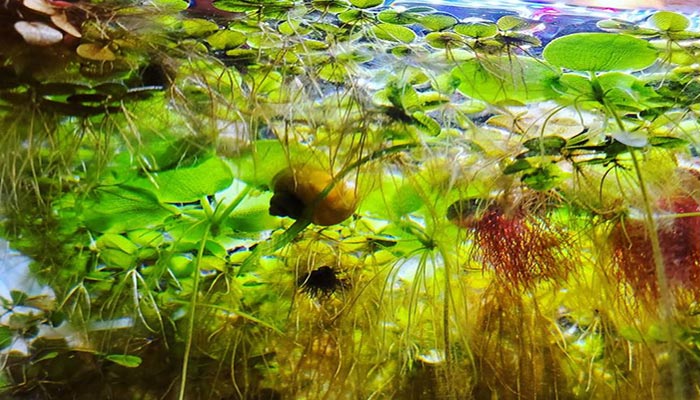
Water Spangles vs Frogbit
Water Spangles and Frogbit are both floating aquatic plants, but they have some differences in appearance, growth habits, and care requirements. Water Spangles have small, oval-shaped leaves covered in tiny hairs and long, feathery roots hanging beneath the water’s surface.
In contrast, Frogbit has larger, round or heart-shaped leaves that resemble miniature lily pads and shorter roots. Water Spangles grow rapidly and can double their biomass in just a few days, whereas Frogbit generally has a more moderate growth rate.
Both plants provide shelter and improve water quality but may have slightly different preferences in terms of light, nutrients, and water parameters.
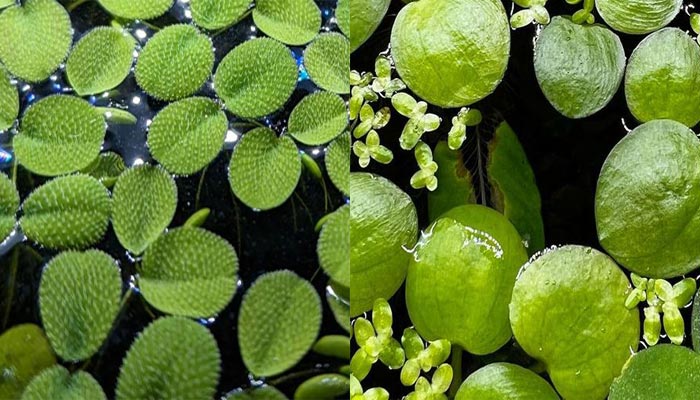
Water Spangles Care
Water Spangles Tank Requirements
Cultivating a Thriving Aquatic Environment order to successfully cultivate these floating ferns, it is essential to understand the tank requirements needed to create a thriving aquatic environment.
Tank size: Sufficient growth
Water Spangles can grow rapidly, so it is crucial to have an adequately sized tank to prevent overcrowding. A tank with a capacity of at least 10 gallons is recommended, but larger tanks will provide more room for growth and better accommodate the needs of fish and other aquatic life.
Lighting: A Key Factor in Water Spangles Growth
Providing the right lighting conditions is crucial for the healthy growth of Water Spangles. These plants thrive in bright lighting, whether it comes from indirect sunlight or artificial light sources. When using artificial light, LED fixtures are an energy-efficient and effective option. Aim for 8-10 hours of light per day, avoiding direct sunlight to prevent leaf burn and excessive algae growth.
Water Parameters: Ensuring Optimal Conditions
Water Spangles are adaptable to a wide range of water parameters, but certain conditions are optimal for their growth. The ideal temperature range for these floating ferns is between 18°C and 30°C (64°F to 86°F). As for pH, Water Spangles prefer slightly acidic to neutral water, with a pH range of 6.0-7.5. Regular monitoring of these parameters will help maintain a stable environment conducive to plant growth.
Water Flow: Balancing Movement and Oxygenation
Water flow is another important aspect of a successful Water Spangles tank. Gentle water movement helps these plants receive enough oxygen and nutrients while preventing stagnation. It is essential to choose a filtration system that promotes circulation and biological filtration without creating strong currents that could push the plants underwater.
Maintenance: Keeping a Healthy and Attractive Environment
Regular maintenance is vital for the successful cultivation of Water Spangles. This includes removing excess plants to prevent overcrowding and ensure adequate light penetration for other aquatic life. Monitor the tank for pests, such as snails or aphids, and address any issues accordingly. Additionally, adding a liquid aquatic plant fertilizer, as per the manufacturer’s instructions, will provide essential nutrients for Water Spangles growth. Be cautious not to over-fertilize, as this can lead to algae growth.
Propagation: Encouraging Healthy Water Spangles Growth
Water Spangles propagate quickly through a process called fragmentation, where small portions of the plant break off and form new plants. This rapid growth can be both a benefit and a challenge. Encourage healthy propagation by providing optimal lighting, water parameters, and nutrient supplementation. However, be prepared to manage their growth to maintain a balanced aquatic environment.
Related: View our latest Aquarium Plant Guides Here!
Water Spangles Planting
Before adding Water Spangles to your main aquarium, quarantine them in a separate container for at least one week. This allows you to observe the plants for any signs of pests, diseases, or other issues that could harm your aquarium’s inhabitants.
During this time, also inspect the plants for any hitchhikers, such as snails or unwanted organisms, and remove them if necessary. Once the quarantine period is complete and the plants are deemed healthy, gently place the Water Spangles on the water’s surface in your aquarium.
There is no need to anchor them, as they will naturally float and spread across the surface. To prevent overcrowding and maintain a healthy environment for other aquatic life, ensure that the Water Spangles cover no more than 50% of the water’s surface.
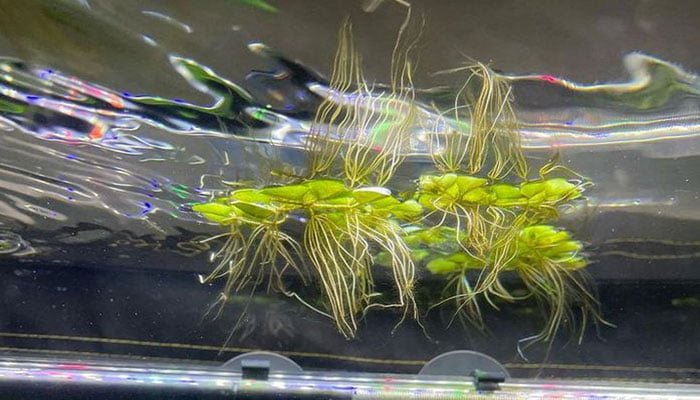
Ongoing Care and Maintenance of Water Spangles
Pruning Water Spangles
Pruning Water Spangles is essential to maintain a balanced aquatic environment and aesthetic appeal. In this article, we will discuss how to effectively prune Water Spangles to manage growth and maintain a healthy aquatic habitat.
- Observe and Assess – Before you begin pruning, observe your aquarium or pond to assess the extent of Water Spangles’ growth. Ideally, these floating ferns should cover no more than 50% of the water’s surface to allow adequate light penetration for other aquatic life and prevent oxygen depletion. If you notice that the Water Spangles have overgrown or are inhibiting the growth of other plants, it’s time to prune.
- Prune Excess Growth To prune – Water Spangles, gently remove a portion of the plants from the water’s surface with your hand or a fine mesh net. Be cautious not to damage the roots or leaves of the remaining plants. Aim to remove enough Water Spangles to achieve the desired coverage while maintaining a balanced aquatic environment. Keep in mind that Water Spangles grow rapidly, so regular pruning may be necessary to manage their growth.
- Dispose of Removed Water Spangles Responsibly – When disposing of the removed Water Spangles, be aware that they are considered invasive in some regions due to their rapid growth and ability to outcompete native plants. Do not dispose of them in natural water bodies, such as lakes, ponds, or streams, as they may cause ecological imbalances and harm native ecosystems. Instead, place the removed plants in a sealed plastic bag and dispose of them with your household waste.
- Monitor and Maintain – After pruning, continue to monitor the growth of your Water Spangles and the overall health of your aquatic environment. Perform regular water tests to ensure optimal water parameters and provide necessary nutrients through liquid aquatic plant fertilizers. Maintain a gentle water flow to promote oxygenation and nutrient distribution.
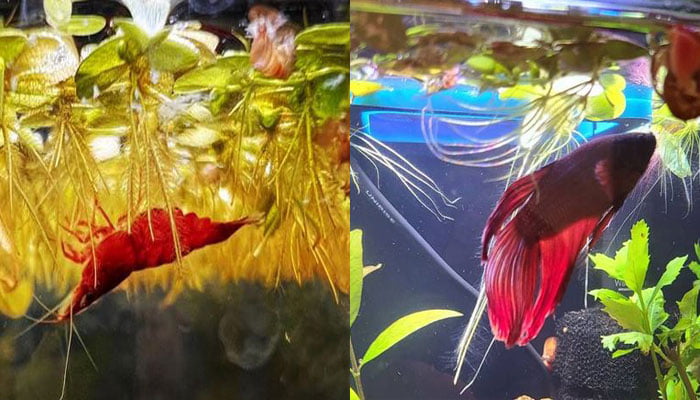
Water Spangles and Tank Mates
Water Spangles can coexist with various tank mates, including turtles, goldfish, shrimp, and catfish, offering numerous benefits such as shelter, food, and improved water quality. By understanding the needs and preferences of each tank mate and implementing proper care and maintenance, you can create a harmonious aquatic environment that is both visually appealing and beneficial to all inhabitants.
Turtles – Water Spangles can provide a source of food and shelter for aquatic turtles. Some turtles, such as red-eared sliders, enjoy munching on these floating ferns, making them an excellent addition to a turtle’s diet. Additionally, the dense mat of Water Spangles creates a hiding spot for turtles, offering them a sense of security in their environment.
Goldfish – Water Spangles can serve as a supplemental food source for goldfish, which are known to be opportunistic feeders. The floating plants also provide cover for goldfish, making them feel more secure in their environment. However, keep in mind that goldfish can produce a significant amount of waste, so maintaining water quality is crucial for the overall health of both the goldfish and the Water Spangles.
Shrimp – Shrimp and Water Spangles have a symbiotic relationship, with shrimp benefiting from the plant’s shelter and food source. The Water Spangles’ root systems host biofilm and microorganisms that provide a valuable food source for shrimp. Additionally, the floating plants create a safe breeding ground for shrimp, offering protection from potential predators. Shrimp love having Water Spangles in their setup. They will hang upside down all day long.
Catfish – Catfish, such as Corydoras and Plecos, can coexist with Water Spangles without any issues. While these bottom-dwelling fish don’t typically interact with floating plants, Water Spangles can still benefit them indirectly. By oxygenating the water and improving water quality, Water Spangles help create a healthier environment for catfish to thrive.
Water Spangles in summery
- Light: Water Spangles thrive in bright, indirect sunlight or moderate artificial light. If you are using artificial light, keep it on for 8-10 hours per day. Direct sunlight should be avoided, as it can cause the leaves to burn or encourage algae growth.
- Water conditions: Water Spangles prefer slightly acidic to neutral water with a pH of 6.0-7.5. They can tolerate a wide range of water temperatures, from 18°C to 30°C (64°F to 86°F). Make sure to maintain stable water conditions to ensure their growth.
- Nutrients: These plants absorb nutrients directly from the water through their roots, so it’s essential to provide them with proper nutrition. You can add a liquid aquatic plant fertilizer to the water according to the manufacturer’s instructions. Avoid adding too much, as this may lead to algae growth.
- Maintenance: Water Spangles grow quickly and can cover the surface of the water, so it’s crucial to remove excess plants regularly. This will help prevent overcrowding and maintain healthy water conditions for your other aquatic life. You can simply scoop out the excess plants with a net.
- Aeration: Adequate water movement and aeration are essential for healthy Water Spangles. Gently circulating water will ensure that the plants receive enough oxygen and nutrients while preventing stagnation. However, avoid creating strong currents, as this can cause the plants to be pushed underwater and drown.
- Propagation: Water Spangles reproduce quickly through a process called budding. They form new plantlets that break off from the parent plant and float away. To propagate, simply allow the plantlets to grow and divide naturally. You can also remove some of the mature plants and place them in another water body.
- Pest control: Keep an eye out for common aquatic pests like snails and aphids. You can remove them manually or use appropriate treatments to control their populations. Be cautious when using chemical treatments, as they can harm other aquatic life and plants.
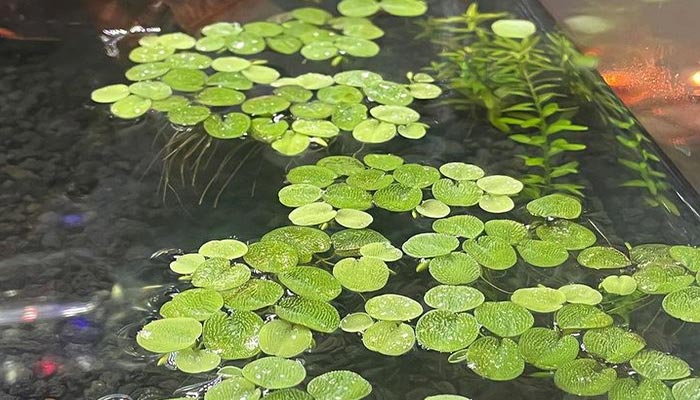
Water Spangles FAQ
How fast do water spangles grow?
Water Spangles (Salvinia minima) exhibit a rapid growth rate, doubling their biomass in just a few days under optimal conditions. Factors such as light intensity, nutrient availability, water temperature, and water quality can influence their growth rate. In favourable environments,
Are water spangles duckweed?
Water Spangles (Salvinia minima) and duckweed (Lemna spp.) are different aquatic plants. Both are floating species, but Water Spangles are ferns with distinct leaves and roots, while duckweed is a small, simple flowering plant. They share similarities in growth habits but are not the same plant.
Why are my water spangles dying or turning brown?
Water Spangles may die due to various factors, including insufficient lighting, inadequate nutrient availability, poor water quality, extreme water temperatures, or overcrowding. Ensuring proper light, maintaining optimal water parameters, and providing essential nutrients can improve their health.
What can I do with excess water spangles?
With excess Water Spangles, you can share them with other aquarium or pond enthusiasts, use them as compost or mulch for your garden, or responsibly dispose of them in a sealed plastic bag as household waste. Avoid introducing them into natural water bodies, as they can become invasive, outcompeting native plants and disrupting local ecosystems.
By following these simple steps, you can provide a healthy environment for your Water Spangles to flourish, adding natural beauty and beneficial functions to your water feature or aquarium.
More Reading

15 Types of Cryptocoryne: Which is Best For Your Aquarium Setup?

16 Awesome Low Light Aquarium Plants (Mosses, Ferns & Stem Plants)


18 Types of Aquarium Moss: Photos, Care, Propagation & Growth Guide
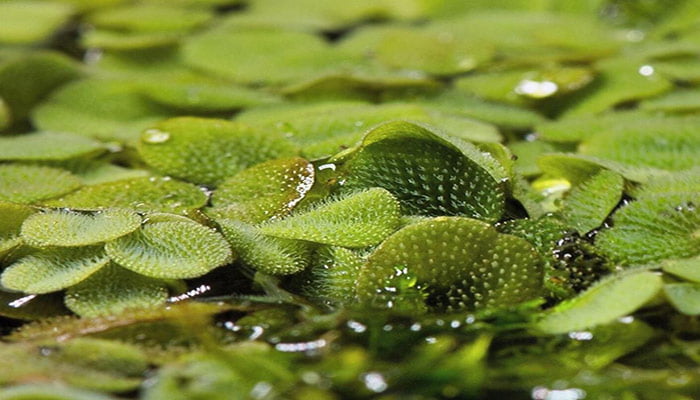
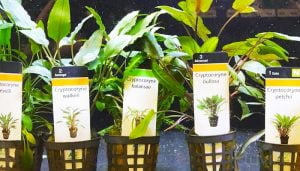
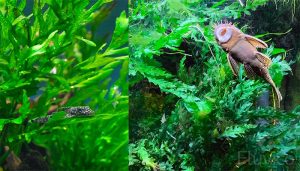
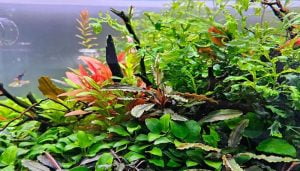

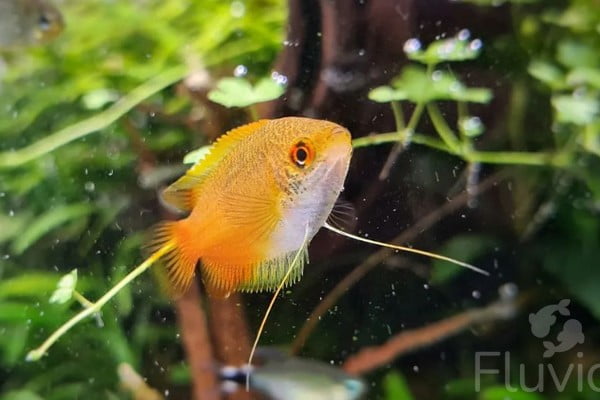
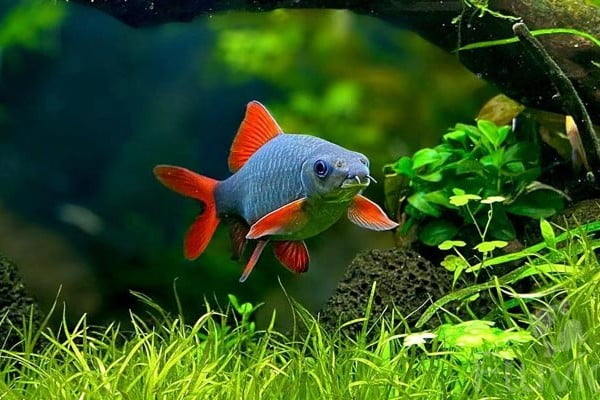
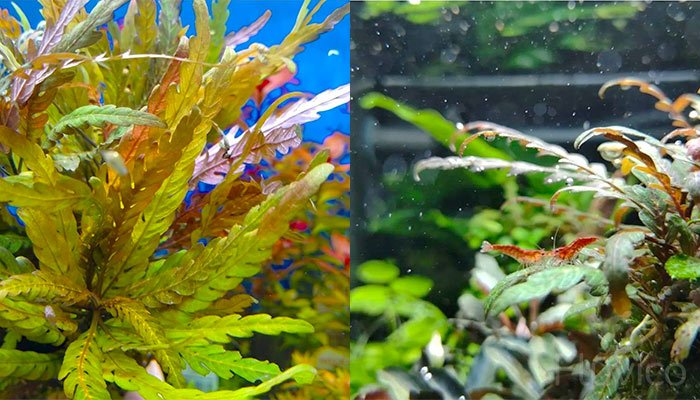

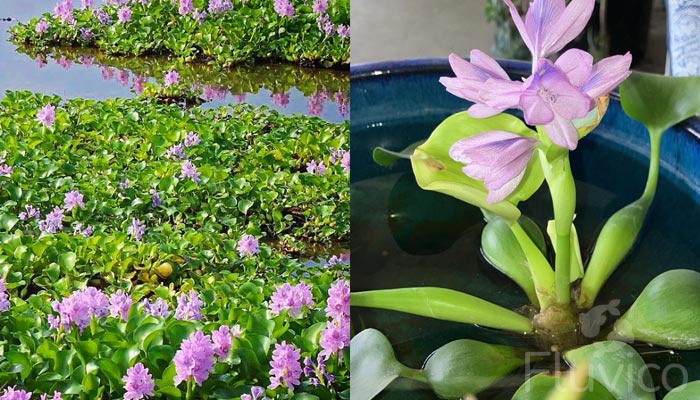
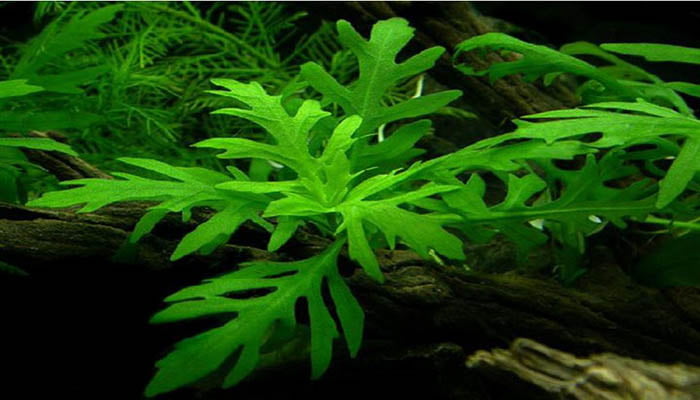
Leave a Comment